Abstract
The human mannose-binding protein (MBP) is a multimeric serum protein that is divided into three domains, a cysteine-rich NH2-terminal domain that stabilizes the collagen alpha helix of the second domain and a third COOH-terminal carbohydrate recognition domain. Previous studies have shown that both native and recombinant human MBP bind to wild-type virulent Salmonella montevideo that expresses a mannose-rich lipopolysaccharide. Interaction with MBP results in opsonization and killing by phagocytes. In this report we show that low concentration of MBP (less than 10 micrograms/ml) markedly enhance complement deposition via the alternative complement pathway on S. montevideo. Despite structural similarities between MBP and the C1q subcomponent of the first complement component, MBP did not restore classical pathway activity to C1q-deficient serum, nor did it activate C1s when added to a mixture of C1r and C1s. In the presence of MBP the C3 bound to S. montevideo during incubation in serum was in the form of C3b and iC3b at a ratio of 1:2. Presensitization of S. montevideo with MBP rendered this normally serum resistant organism susceptible to complement-mediated killing. These results emphasize that MBP and complement cooperate in first line defense of the nonimmune host.
Full text
PDF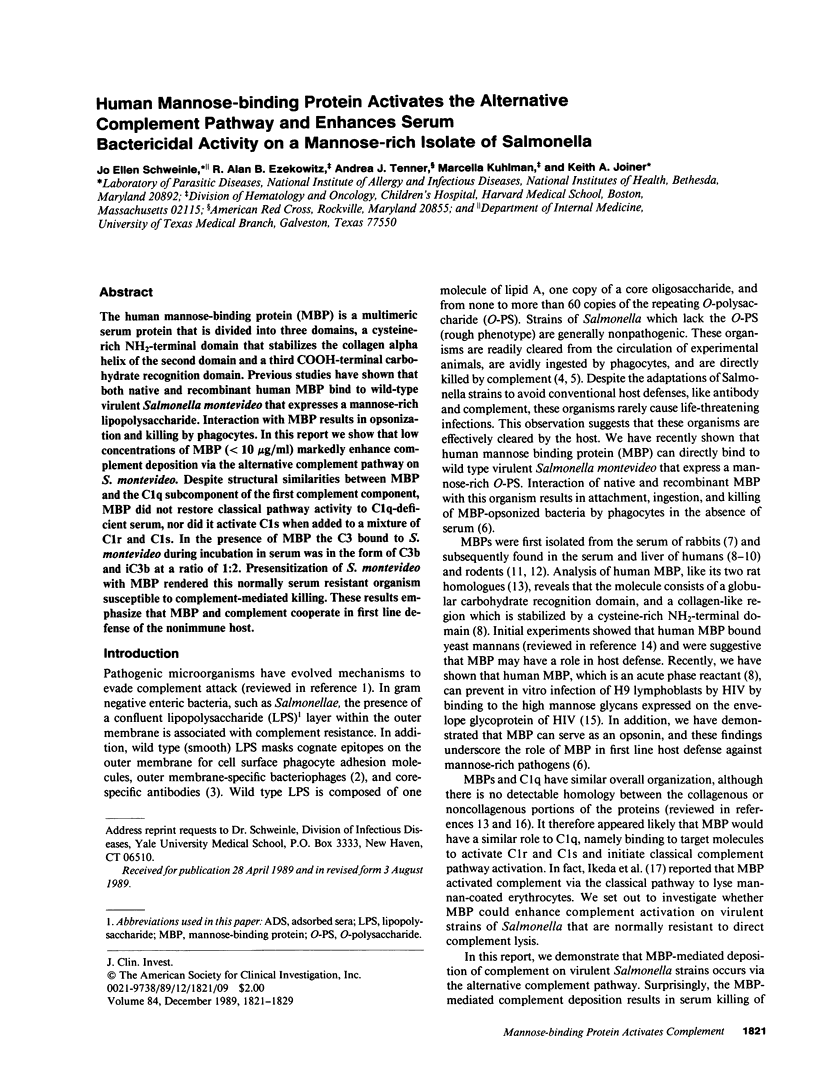
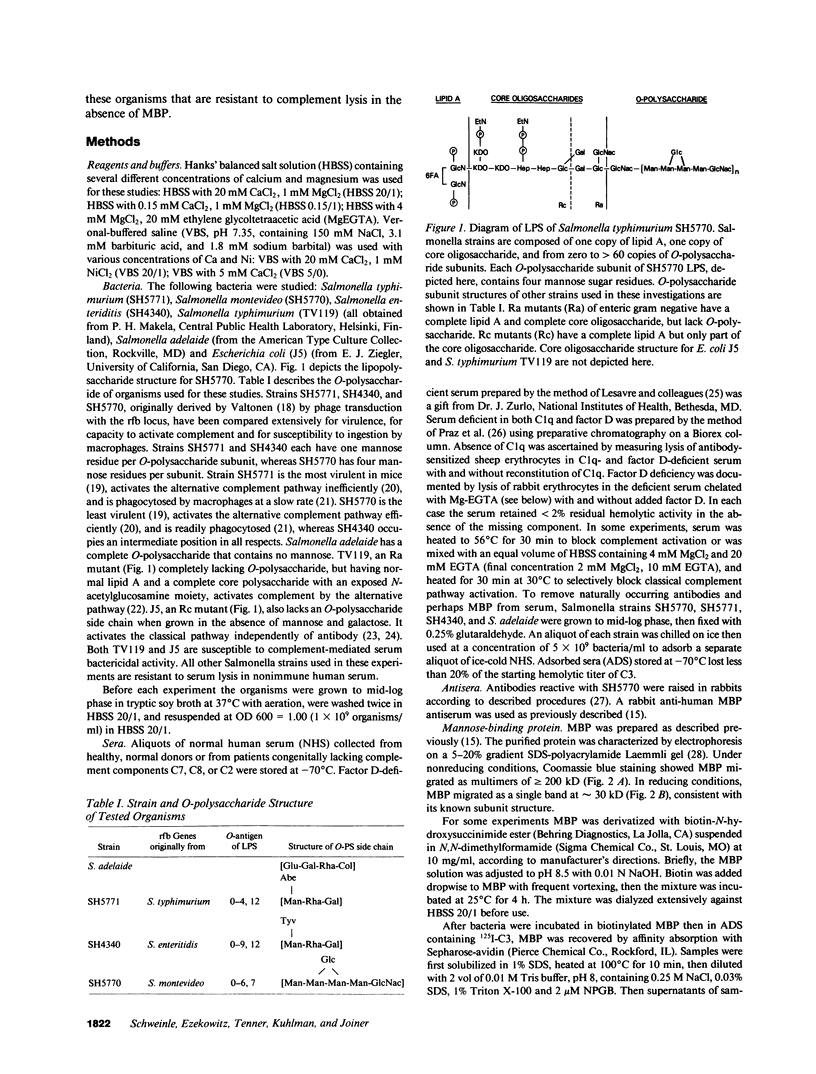
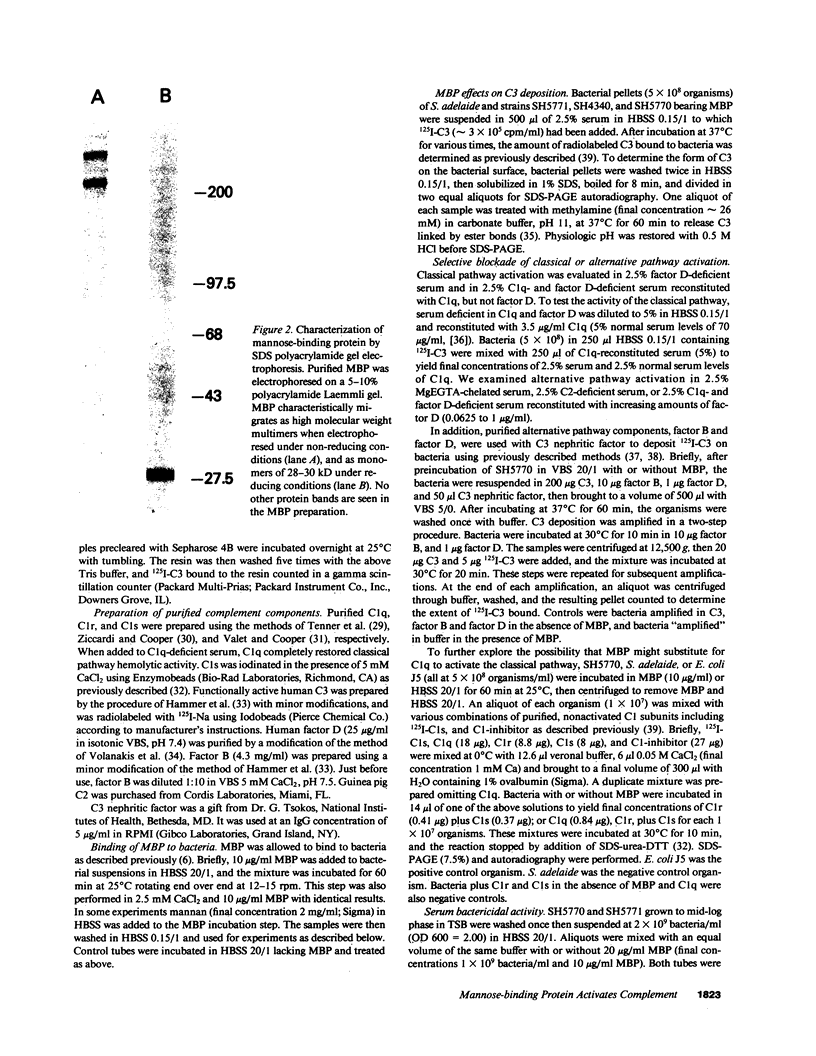
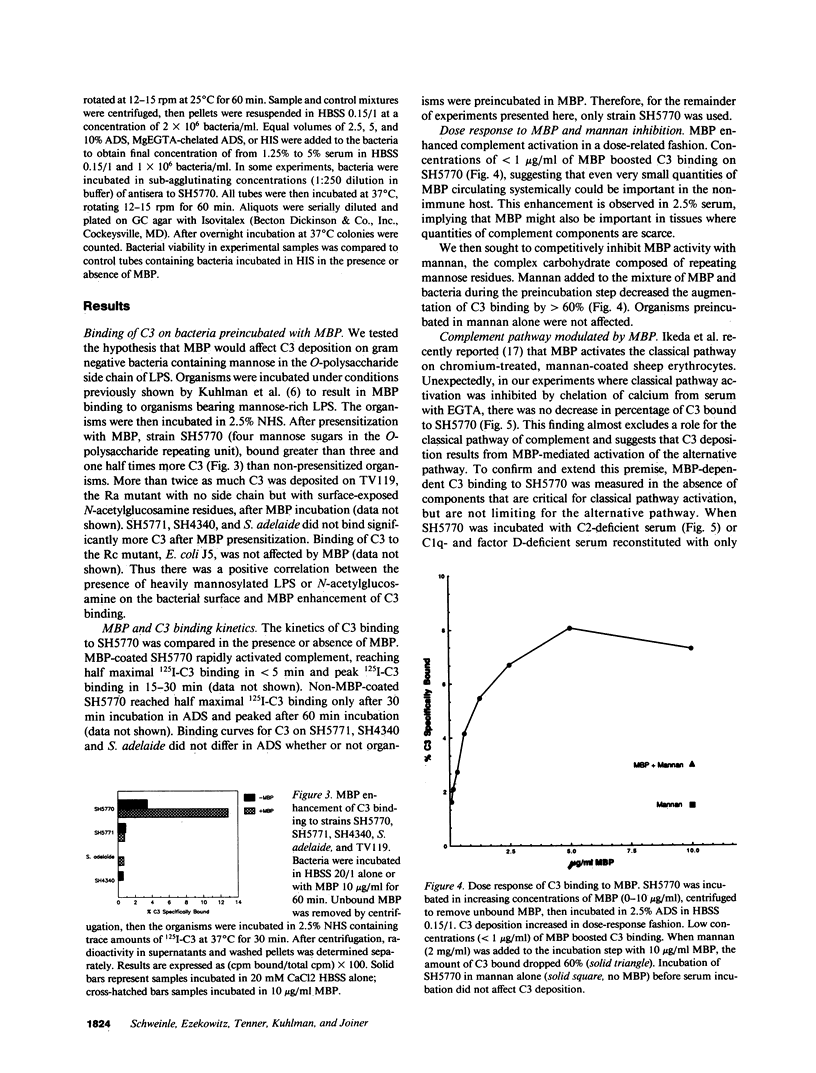
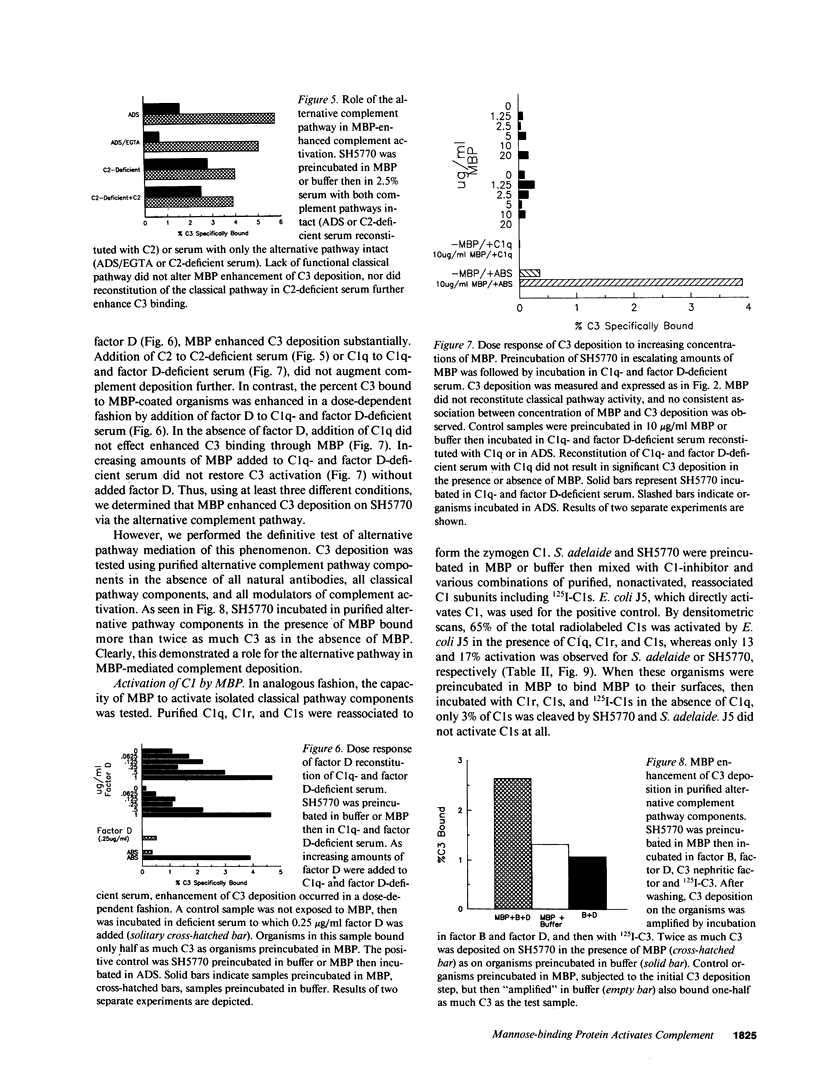
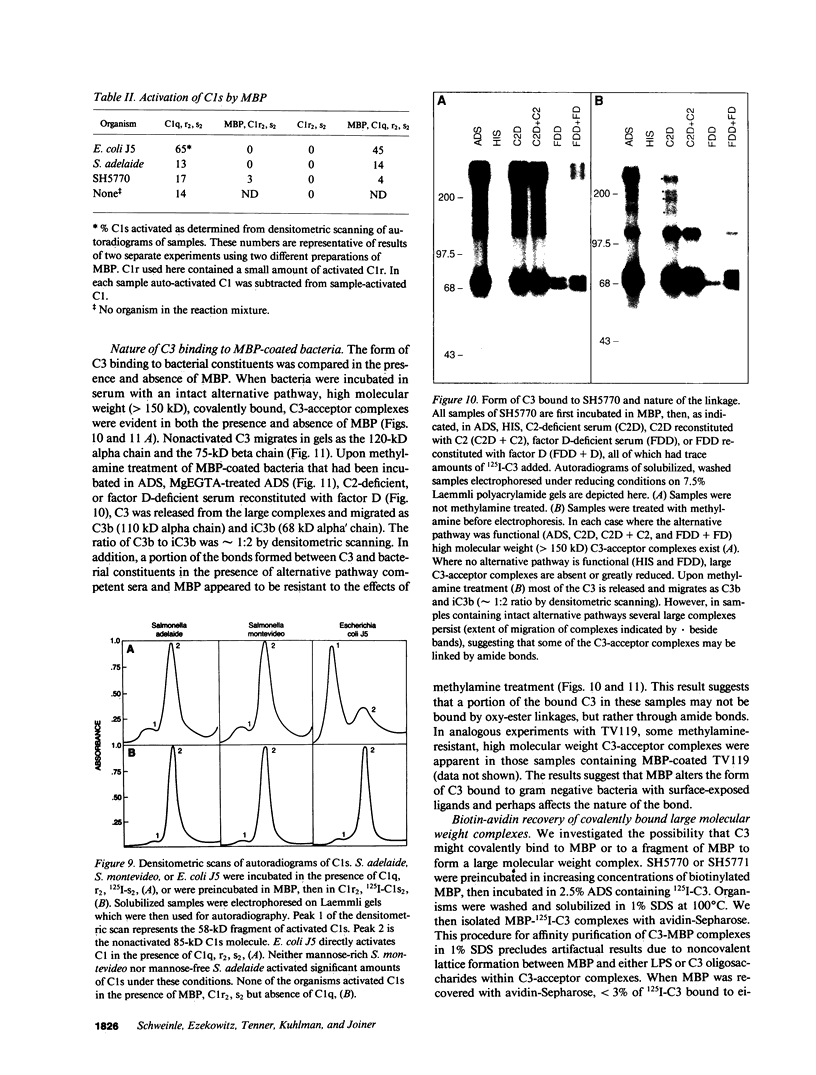
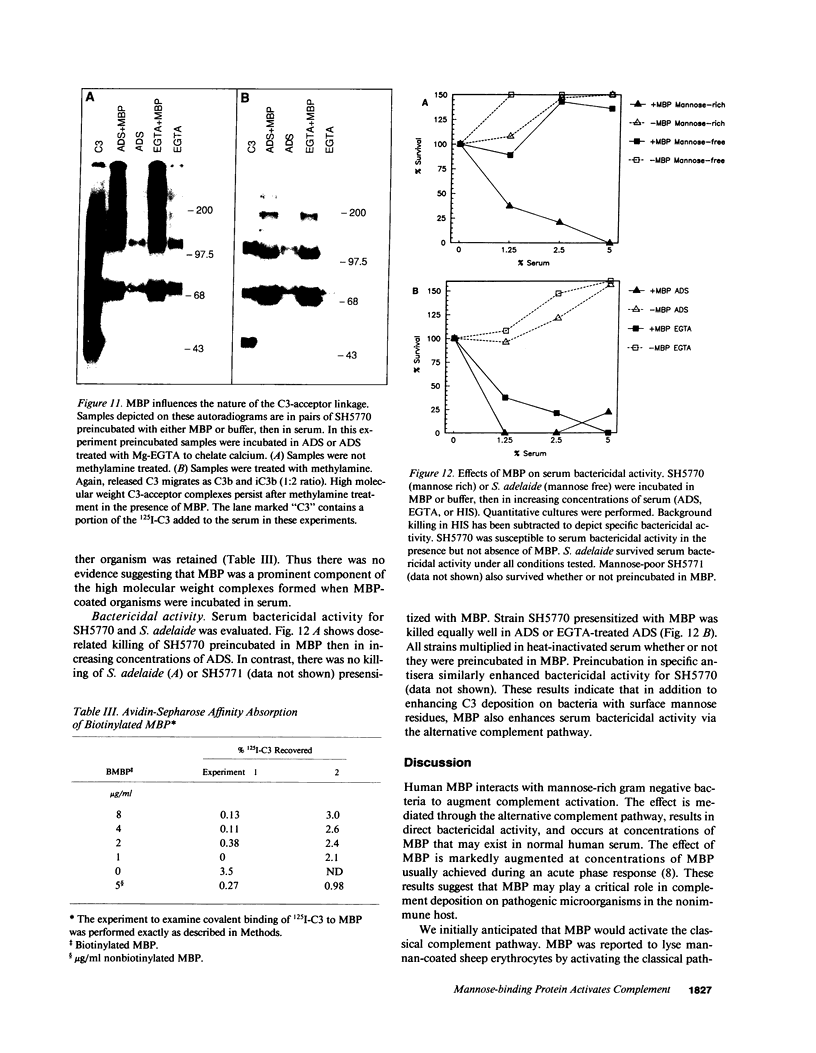
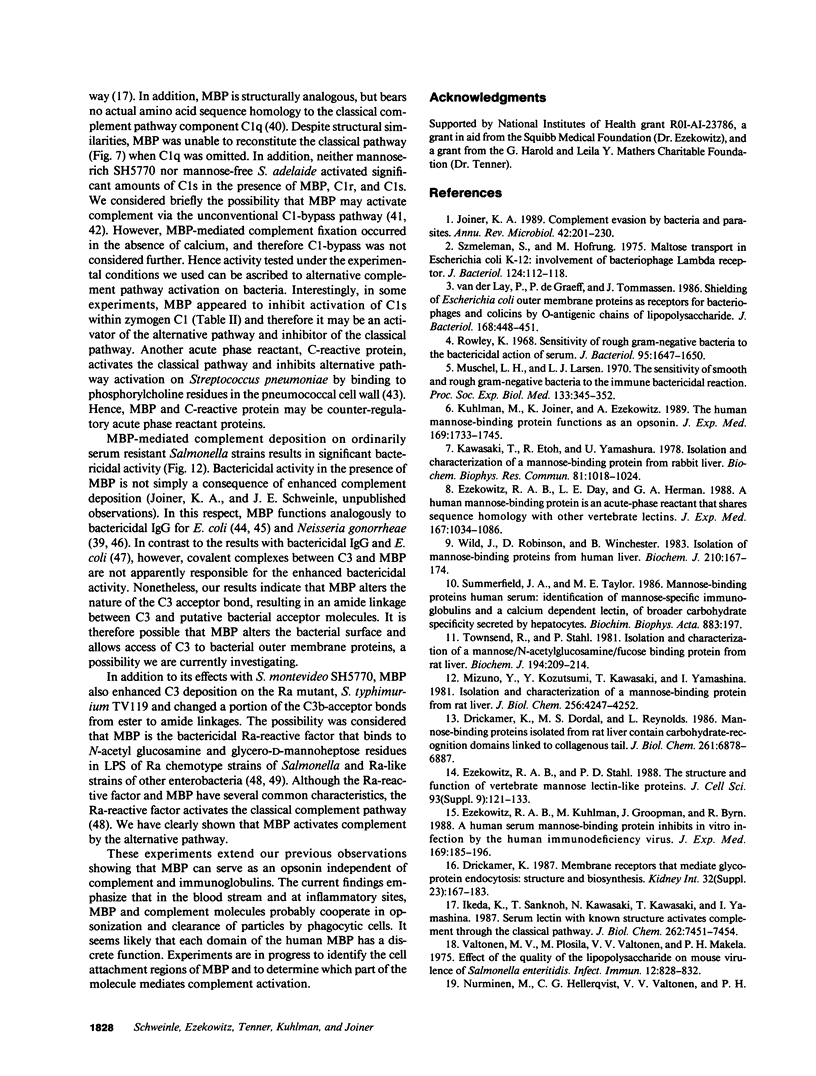
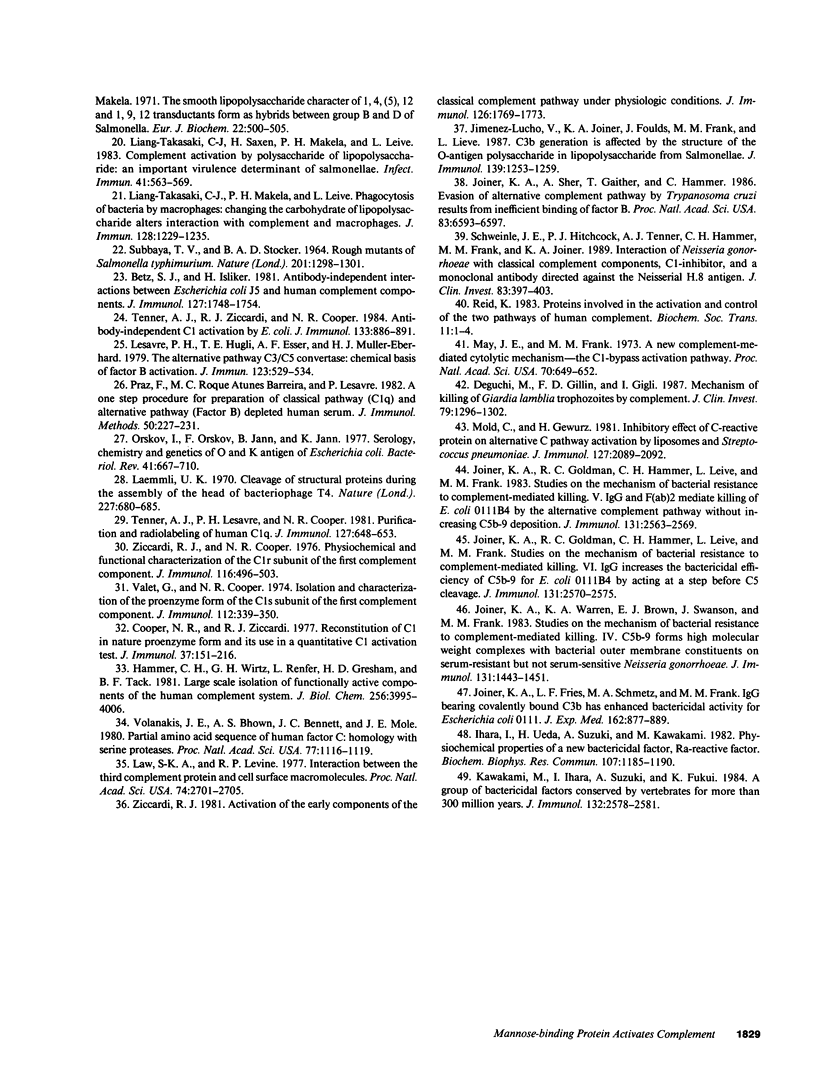
Images in this article
Selected References
These references are in PubMed. This may not be the complete list of references from this article.
- Betz S. J., Isliker H. Antibody-independent interactions between Escherichia coli J5 and human complement components. J Immunol. 1981 Nov;127(5):1748–1754. [PubMed] [Google Scholar]
- Deguchi M., Gillin F. D., Gigli I. Mechanism of killing of Giardia lamblia trophozoites by complement. J Clin Invest. 1987 May;79(5):1296–1302. doi: 10.1172/JCI112952. [DOI] [PMC free article] [PubMed] [Google Scholar]
- Drickamer K., Dordal M. S., Reynolds L. Mannose-binding proteins isolated from rat liver contain carbohydrate-recognition domains linked to collagenous tails. Complete primary structures and homology with pulmonary surfactant apoprotein. J Biol Chem. 1986 May 25;261(15):6878–6887. [PubMed] [Google Scholar]
- Ezekowitz R. A., Day L. E., Herman G. A. A human mannose-binding protein is an acute-phase reactant that shares sequence homology with other vertebrate lectins. J Exp Med. 1988 Mar 1;167(3):1034–1046. doi: 10.1084/jem.167.3.1034. [DOI] [PMC free article] [PubMed] [Google Scholar]
- Ezekowitz R. A., Kuhlman M., Groopman J. E., Byrn R. A. A human serum mannose-binding protein inhibits in vitro infection by the human immunodeficiency virus. J Exp Med. 1989 Jan 1;169(1):185–196. doi: 10.1084/jem.169.1.185. [DOI] [PMC free article] [PubMed] [Google Scholar]
- Ezekowitz R. A., Stahl P. D. The structure and function of vertebrate mannose lectin-like proteins. J Cell Sci Suppl. 1988;9:121–133. doi: 10.1242/jcs.1988.supplement_9.6. [DOI] [PubMed] [Google Scholar]
- Hammer C. H., Wirtz G. H., Renfer L., Gresham H. D., Tack B. F. Large scale isolation of functionally active components of the human complement system. J Biol Chem. 1981 Apr 25;256(8):3995–4006. [PubMed] [Google Scholar]
- Ihara I., Ueda H., Suzuki A., Kawakami M. Physicochemical properties of a new bactericidal factor, Ra-reactive factor. Biochem Biophys Res Commun. 1982 Aug 31;107(4):1185–1190. doi: 10.1016/s0006-291x(82)80122-8. [DOI] [PubMed] [Google Scholar]
- Ikeda K., Sannoh T., Kawasaki N., Kawasaki T., Yamashina I. Serum lectin with known structure activates complement through the classical pathway. J Biol Chem. 1987 Jun 5;262(16):7451–7454. [PubMed] [Google Scholar]
- Jimenez-Lucho V. E., Joiner K. A., Foulds J., Frank M. M., Leive L. C3b generation is affected by the structure of the O-antigen polysaccharide in lipopolysaccharide from salmonellae. J Immunol. 1987 Aug 15;139(4):1253–1259. [PubMed] [Google Scholar]
- Joiner K. A. Complement evasion by bacteria and parasites. Annu Rev Microbiol. 1988;42:201–230. doi: 10.1146/annurev.mi.42.100188.001221. [DOI] [PubMed] [Google Scholar]
- Joiner K. A., Goldman R. C., Hammer C. H., Leive L., Frank M. M. Studies of the mechanism of bacterial resistance to complement-mediated killing. V. IgG and F(ab')2 mediate killing of E. coli 0111B4 by the alternative complement pathway without increasing C5b-9 deposition. J Immunol. 1983 Nov;131(5):2563–2569. [PubMed] [Google Scholar]
- Joiner K. A., Warren K. A., Brown E. J., Swanson J., Frank M. M. Studies on the mechanism of bacterial resistance to complement-mediated killing. IV. C5b-9 forms high molecular weight complexes with bacterial outer membrane constituents on serum-resistant but not on serum-sensitive Neisseria gonorrhoeae. J Immunol. 1983 Sep;131(3):1443–1451. [PubMed] [Google Scholar]
- Joiner K., Sher A., Gaither T., Hammer C. Evasion of alternative complement pathway by Trypanosoma cruzi results from inefficient binding of factor B. Proc Natl Acad Sci U S A. 1986 Sep;83(17):6593–6597. doi: 10.1073/pnas.83.17.6593. [DOI] [PMC free article] [PubMed] [Google Scholar]
- Kawakami M., Ihara I., Ihara S., Suzuki A., Fukui K. A group of bactericidal factors conserved by vertebrates for more than 300 million years. J Immunol. 1984 May;132(5):2578–2581. [PubMed] [Google Scholar]
- Kawasaki T., Etoh R., Yamashina I. Isolation and characterization of a mannan-binding protein from rabbit liver. Biochem Biophys Res Commun. 1978 Apr 14;81(3):1018–1024. doi: 10.1016/0006-291x(78)91452-3. [DOI] [PubMed] [Google Scholar]
- Kuhlman M., Joiner K., Ezekowitz R. A. The human mannose-binding protein functions as an opsonin. J Exp Med. 1989 May 1;169(5):1733–1745. doi: 10.1084/jem.169.5.1733. [DOI] [PMC free article] [PubMed] [Google Scholar]
- Laemmli U. K. Cleavage of structural proteins during the assembly of the head of bacteriophage T4. Nature. 1970 Aug 15;227(5259):680–685. doi: 10.1038/227680a0. [DOI] [PubMed] [Google Scholar]
- Law S. K., Levine R. P. Interaction between the third complement protein and cell surface macromolecules. Proc Natl Acad Sci U S A. 1977 Jul;74(7):2701–2705. doi: 10.1073/pnas.74.7.2701. [DOI] [PMC free article] [PubMed] [Google Scholar]
- Lesavre P. H., Hugli T. E., Esser A. F., Müller-Eberhard H. J. The alternative pathway C3/C5 convertase: chemical basis of factor B activation. J Immunol. 1979 Aug;123(2):529–534. [PubMed] [Google Scholar]
- Liang-Takasaki C. J., Mäkelä P. H., Leive L. Phagocytosis of bacteria by macrophages: changing the carbohydrate of lipopolysaccharide alters interaction with complement and macrophages. J Immunol. 1982 Mar;128(3):1229–1235. [PubMed] [Google Scholar]
- Liang-Takasaki C. J., Saxén H., Mäkelä P. H., Leive L. Complement activation by polysaccharide of lipopolysaccharide: an important virulence determinant of salmonellae. Infect Immun. 1983 Aug;41(2):563–569. doi: 10.1128/iai.41.2.563-569.1983. [DOI] [PMC free article] [PubMed] [Google Scholar]
- May J. E., Frank M. M. A new complement-mediated cytolytic mechanism--the C1-bypass activation pathway. Proc Natl Acad Sci U S A. 1973 Mar;70(3):649–652. doi: 10.1073/pnas.70.3.649. [DOI] [PMC free article] [PubMed] [Google Scholar]
- Mizuno Y., Kozutsumi Y., Kawasaki T., Yamashina I. Isolation and characterization of a mannan-binding protein from rat liver. J Biol Chem. 1981 May 10;256(9):4247–4252. [PubMed] [Google Scholar]
- Mold C., Gewurz H. Inhibitory effect of C-reactive protein on alternative C pathway activation by liposomes and Streptococcus pneumoniae. J Immunol. 1981 Nov;127(5):2089–2092. [PubMed] [Google Scholar]
- Muschel L. H., Larsen L. J. The sensitivity of smooth and rough gram-negative bacteria to the immune bactericidal reaction. Proc Soc Exp Biol Med. 1970 Jan;133(1):345–348. doi: 10.3181/00379727-133-34472. [DOI] [PubMed] [Google Scholar]
- Nurminen M., Hellerqvist C. G., Valtonen V. V., Mäkelä P. H. The smooth lipopolysaccharide character of 1,4,(5),12 and 1,9,12 transductants formed as hybrids between groups B and D of salmonella. Eur J Biochem. 1971 Oct 26;22(4):500–505. doi: 10.1111/j.1432-1033.1971.tb01569.x. [DOI] [PubMed] [Google Scholar]
- Orskov I., Orskov F., Jann B., Jann K. Serology, chemistry, and genetics of O and K antigens of Escherichia coli. Bacteriol Rev. 1977 Sep;41(3):667–710. doi: 10.1128/br.41.3.667-710.1977. [DOI] [PMC free article] [PubMed] [Google Scholar]
- Praz F., Roque Antunes Barreira M. C., Lesavre P. A one-step procedure for preparation of classical pathway (C1q) and alternative pathway (factor D) depleted human serum. J Immunol Methods. 1982;50(2):227–231. doi: 10.1016/0022-1759(82)90229-0. [DOI] [PubMed] [Google Scholar]
- Reid K. B. Proteins involved in the activation and control of the two pathways of human complement. Biochem Soc Trans. 1983 Jan;11(1):1–12. doi: 10.1042/bst0110001. [DOI] [PubMed] [Google Scholar]
- Rowley D. Sensitivity of rough gram-negative bacteria to the bactericidal action of serum. J Bacteriol. 1968 May;95(5):1647–1650. doi: 10.1128/jb.95.5.1647-1650.1968. [DOI] [PMC free article] [PubMed] [Google Scholar]
- SUBBAIAH T. V., STOCKER B. A. ROUGH MUTANTS OF SALMONELLA TYPHIMURIUM. I. GENETICS. Nature. 1964 Mar 28;201:1298–1299. doi: 10.1038/2011298a0. [DOI] [PubMed] [Google Scholar]
- Schweinle J. E., Hitchcock P. J., Tenner A. J., Hammer C. H., Frank M. M., Joiner K. A. Interaction of Neisseria gonorrhoeae with classical complement components, C1-inhibitor, and a monoclonal antibody directed against the Neisserial H.8 antigen. J Clin Invest. 1989 Feb;83(2):397–403. doi: 10.1172/JCI113897. [DOI] [PMC free article] [PubMed] [Google Scholar]
- Summerfield J. A., Taylor M. E. Mannose-binding proteins in human serum: identification of mannose-specific immunoglobulins and a calcium-dependent lectin, of broader carbohydrate specificity, secreted by hepatocytes. Biochim Biophys Acta. 1986 Sep 4;883(2):197–206. doi: 10.1016/0304-4165(86)90309-0. [DOI] [PubMed] [Google Scholar]
- Szmelcman S., Hofnung M. Maltose transport in Escherichia coli K-12: involvement of the bacteriophage lambda receptor. J Bacteriol. 1975 Oct;124(1):112–118. doi: 10.1128/jb.124.1.112-118.1975. [DOI] [PMC free article] [PubMed] [Google Scholar]
- Tenner A. J., Lesavre P. H., Cooper N. R. Purification and radiolabeling of human C1q. J Immunol. 1981 Aug;127(2):648–653. [PubMed] [Google Scholar]
- Tenner A. J., Ziccardi R. J., Cooper N. R. Antibody-independent C1 activation by E. coli. J Immunol. 1984 Aug;133(2):886–891. [PubMed] [Google Scholar]
- Townsend R., Stahl P. Isolation and characterization of a mannose/N-acetylglucosamine/fucose-binding protein from rat liver. Biochem J. 1981 Jan 15;194(1):209–214. doi: 10.1042/bj1940209. [DOI] [PMC free article] [PubMed] [Google Scholar]
- Valet G., Cooper N. R. Isolation and characterization of the proenzyme form of the C1s subunit of the first complement component. J Immunol. 1974 Jan;112(1):339–350. [PubMed] [Google Scholar]
- Valtonen M. V., Plosila M., Valtonen V. V., Mäkelä P. H. Effect of the quality of the lipopolysaccharide on mouse virulence of Salmonella enteritidis. Infect Immun. 1975 Oct;12(4):828–832. doi: 10.1128/iai.12.4.828-832.1975. [DOI] [PMC free article] [PubMed] [Google Scholar]
- Volanakis J. E., Bhown A., Bennett J. C., Mole J. E. Partial amino acid sequence of human factor D:homology with serine proteases. Proc Natl Acad Sci U S A. 1980 Feb;77(2):1116–1119. doi: 10.1073/pnas.77.2.1116. [DOI] [PMC free article] [PubMed] [Google Scholar]
- Wild J., Robinson D., Winchester B. Isolation of mannose-binding proteins from human and rat liver. Biochem J. 1983 Jan 15;210(1):167–174. doi: 10.1042/bj2100167. [DOI] [PMC free article] [PubMed] [Google Scholar]
- Ziccardi R. J. Activation of the early components of the classical complement pathway under physiologic conditions. J Immunol. 1981 May;126(5):1769–1773. [PubMed] [Google Scholar]
- Ziccardi R. J., Cooper N. R. Physicochemical and functional characterization of the C1r subunit of the first complement component. J Immunol. 1976 Feb;116(2):496–503. [PubMed] [Google Scholar]
- van der Ley P., de Graaff P., Tommassen J. Shielding of Escherichia coli outer membrane proteins as receptors for bacteriophages and colicins by O-antigenic chains of lipopolysaccharide. J Bacteriol. 1986 Oct;168(1):449–451. doi: 10.1128/jb.168.1.449-451.1986. [DOI] [PMC free article] [PubMed] [Google Scholar]






